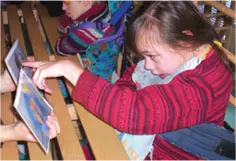
Social and Employment
Place
Nord, France
Sponsor
Denis Bobillier
Grant(s)
10,000 € to the Selection Committee at 2007/12/04
Project leader
"My daughter Diane, who is herself multihandicapped due to an orphan chromosomic disease, has followed this method successfully for three years."
Denis Bobillier
In 1991, Olivier and Diane Delplanque, the parents of Noemi, discovered the multihandicap of their daughter. Determined to offer her a normal life, they sought an educational system to help her develop physically and psychologically. They could not find a single structure in France, nor any teaching system to help promote the blossoming of the children suffering the same handicaps as their daughter. For example, during the three months of training of a specialized educator, only a few hours are devoted to the multihandicapped.
So it was finally across the Atlantic that they found out about conductive educational teaching, conceived and developed by a Hungarian doctor, Dr. Andreas Peto. Thanks to this method, their daughter has really flourished. Olivier Delplanque therefore decided to found the Noemi Association in 1999 to introduce conductive education in France and have it recognized, and thereby improve the accompaniment of multihandicapped persons, which is usually limited to supervision or simple medical assistance.
A method for gaining more self-sufficiency
This method structures the approach of the multihandicapped child by stimulating it to make it acquire the most self-sufficiency possible (drinking alone, playing alone, pressing a switch to request something, etc.). It draws on group emulation techniques and rehabilitation by physiotherapy, ergotherapy and orthophony. As opposed to hyperstimulation methods, conductive education is based on the participation and the instilling of self confidence in the child around collective or individual play exercises.
Conductive education, which is still poorly known in France, but adopted in many countries of Europe and the United States with positive results, is occasionally applied in a number of specialized establishments.
The backing of the Veolia Foundation will allow the production of an educational film which the association will play for professionals in order to disseminate the conductive method and to elicit requests for training from them, of which the costs will be taken over by Noemi.

